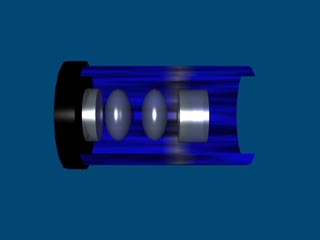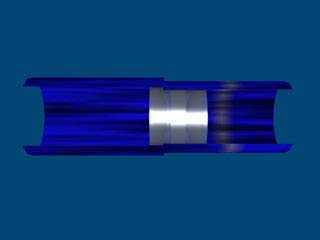 |
|
||||||||||||||
![]()
Selecting
an Eyepiece
by Don Ware
Before explaining the choices of eyepieces that are available it is important to discuss: Telescope Performance.
We have all seen the pretty boxes at department stores advertising 650 power (650X) or 1200 power (1200X). Sounds pretty impressive, doesn’t it? The fact is the amount of power a telescope can magnify isn’t the most important thing when observing.
Most avid amateur astronomers know the truth.
The best telescopes and eyepieces provide good contrast and bright images.
Why is that so important? The reason is that most astronomical objects are really quite large, but usually very faint.
The most critical things to amateur observers is the ability of the telescope to gather as much light as possible, a telescope with good collimation, a dark sky site and of course a clear and steady atmosphere.
Magnification: Some Basic Facts
The focal length of your telescope’s mirror or main lens is inscribed somewhere on the tube assembly, or it will be on the focusing mechanism. Each eyepiece will also have its focal length inscribed on them as well.
The exact magnification can be determined by means of the following formula:
|
Main focal length (in millimeters) |
|
| Magnification = |
|
|
Eyepiece focal length (in millimeters) |
Lets say your telescope has inscribed 1000 mm on the tube assembly, and you have an eyepiece that has 10 mm of focal length. Using the formula the magnification is 1000/10 or 100X. If you had a 40 mm eyepiece you would have 25X in magnification.
Lower Limit
Very low magnifications are quite suitable to look at deep sky objects. There is a practical lower limit. As magnification becomes smaller, the "exit pupil", ( diameter of the light beam that passes into your eye) becomes larger. When the beam exceeds the size of your pupils dark adapted size (about 7 mm), it will be too large to be seen with a result of loss of light.
You can determine the exit pupil of a given telescope and eyepiece by using the following formula:
|
Telescope Aperture (mm) |
|
| Exit Pupil = |
|
|
Magnification |
If your
lens or mirror has a diameter of 100 mm and you are using a 25X eyepiece,
the exit pupil will be 4 mm. On the same telescope you can effectively
use a magnification as low as 14X, which would yield a 7 mm exit pupil.
Age will also effect the maximum exit pupil size, as you grow older,
your eyes will not open as wide as 7 mm.
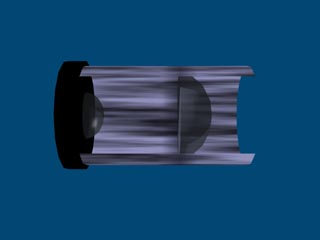 |
|
Hugeyns Design Huygens eyepieces are generally the least costly eyepieces on the market. Huygens eyepieces incorporate two optical elements. They perform quite well on long focus refracting telescopes, but they can show image distortion as the telescope's focal length becomes shorter. Huygens are very good for projection of solar images since they don't use cement to hold the lens elements. |
|
|
|
Plossl Design Plossl's incorporate at least 4 optical elements. The plossl design is a very well designed eyepiece, I would highly recommend them if you are using a Newtonian telescope with a very short local length. Plossl's are very costly to make and hence a lot more expensive than the other designs mentioned so far. Inexpensive plossl's usually exhibit some degree of internal reflection, which is not present in the more expensive models. Plossls generally have a wide field of view and generous eye relief. If there is such a thing as a good all around eye piece for observing then these are it: planet viewing, lunar observing or for deep sky objects. |
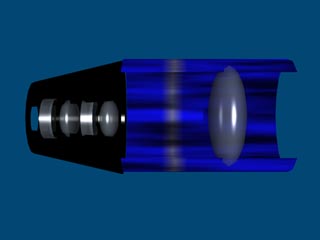 |
|
Erfle Design Erfle usually incorporate 5 to 6 optical elements. Erfle are designed to give a very wide field of view, usually from 60-70°. The Erfle is usually less expensive than the plossl's. However they can suffer from considerable image distortion near the edge of the field of view when used at high magnification. They are most useful for observing deep sky objects. |
|
|
|
Barlow Lens A Barlow lens isn't actually an eyepiece, it simply multiplies the amount of magnification of the eyepiece. Barlows come in 1.5X, 2.0X, 2.5X and 3.0X. Barlows are mostly used for planetary and binary star observation. Barlows must be of high quality though or the resulting image will be badly distorted. |
![]()
![]()
![]()
Upper
Limit
One limit of maximum magnification is the earth's atmosphere, as a rule of thumb you should use magnifications lower than 500X as this will lessen the distortion effects caused by the earth's atmosphere.
Another limit is placed on the telescope by the size of the aperature. As a rule of thumb the upper limit on the magnification is the Aperture of the telescope (in millimeters) times 2.0. Magnifications above this limit may be possible, but distortion effects caused by the mirror or lens will greatly effect the image quality. In our 100 mm telescope example the maximum useful limit would be around 200X.
Seperation
Another useful performance detail is the amount of resolving power the telescope has. This is a function of the aperture of the telescope, and it is the ability to seperate details, such as double stars. In our 100 mm telescope we want to know if we have enough resolving power to see a double star which is seperated by 2 seconds of arc.
The formula for determining resolving power is given by
|
11.6 |
|
| SEP (arc-seconds) = |
|
|
Aperture of the Telescope (cm) |
In our 100 mm telescope we would calculate 11.6/10 or 1.16 arc-seconds of resolving power should be able to resolve a 2-arc second seperation in our double star.
Eyepieces
Now that I have explained some of the factors of telescope performance, lets take a look at the choices of eyepieces that are available.
Eyepieces come in several diameters: 0.96 inch, 1.25 inch, and 2 inch. The 0.96 inch eyepieces are generally found on cheap department store telescopes, I would not recommend buying a telescope only capable of using them, as they can be very difficult to find.
The more common sizes are 1.25 and 2.0.
Eyepieces not only vary in size, and focal length but also in design. The simpilest designs give acceptable performance and in some cases even excellent performance.
The cost of an eyepiece is generally determined by its complexity. The market is literally flooded with eyepieces, all of which are geared to achieving the best field of view, magnification without sacrificing image quality.
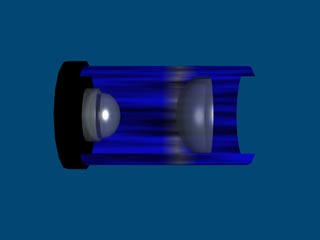 |
| Kellner Design
Kellner eyepieces incorporate 3 optical elements. Kellners offer about a 40° field of view. There are two parts to a Kellner eyepiece, the field lens and the eye lens. The field lens is a single as in the Huygens design, but the eye lens is a doublet (double lens), which is cemented together. Kellners provide a wider field of view and a generally better image quality than the Huygens. If Kellners are used on short focal length telescopes, considerable image distortion near the edge of the field can result. They are still a very useful lens and generally a good buy. |
 |
|
Orthoscopic Design There are many variations of this design around, some are called orthoscopic or ultimate. Usually orthoscopic designs incorporate 4 elements. The field lens is generally similiar to the Hugens and the Kellner and is usually a single. The eye lens is a cemented doublet or triplet. The Orthoscopic is one of the best eye peices for short focal length telescopes. Ortho's provide good image correction and fine image. Orthoscopics have one other property for eyeglass wearers, they provide good eye relief (distance from eye to eyepiece), so you can stand back from the eyepiece and still see a good image, perfect for people who wear glasses. The orthoscopic is also a good choice for viewing planets and the moon. |
| (Various designs) |
|
Ultra-Wide Types Various improved designs incorporating 6 to 8 lens elements boast apparent fields up to 85°-so wide you have to move your eye around to take in the whole panorama. Light transmission is slightly diminished, but otherwise the image quality in these eyepieces is very high. So is their price. |
![]()

copyright © Peoria Astronomical Society 1994-2004.
